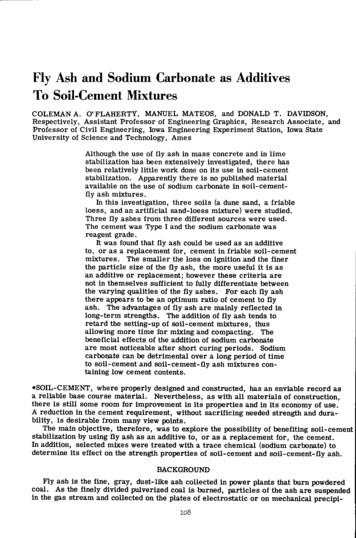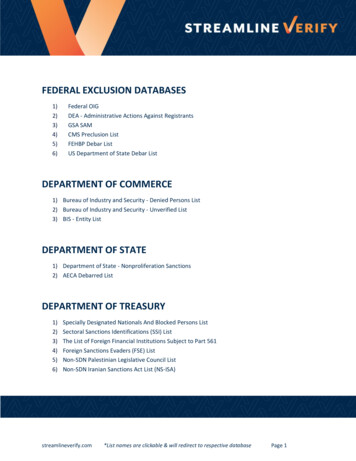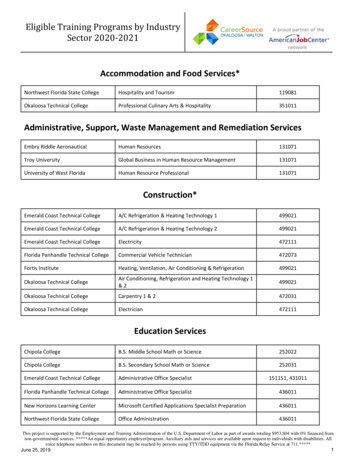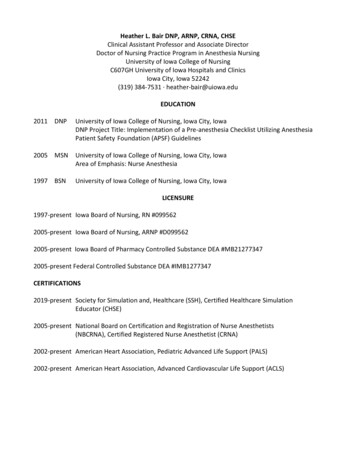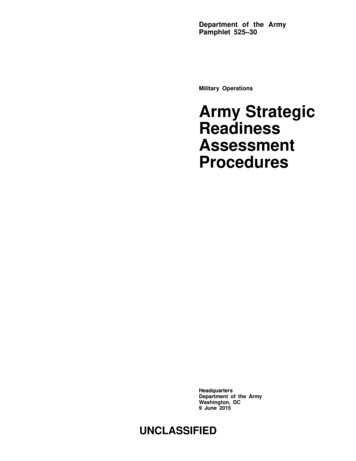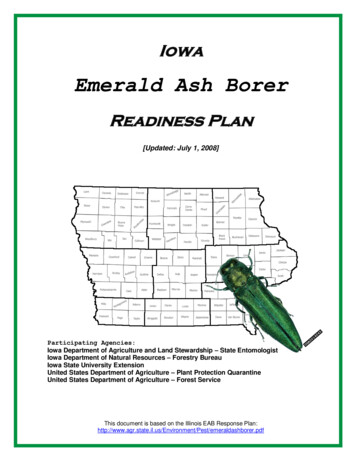
Transcription
IowaEmerald Ash BorerReadiness Plan[Updated: July 1, 2008]Participating Agencies:Iowa Department of Agriculture and Land Stewardship – State EntomologistIowa Department of Natural Resources – Forestry BureauIowa State University ExtensionUnited States Department of Agriculture – Plant Protection QuarantineUnited States Department of Agriculture – Forest ServiceThis document is based on the Illinois EAB Response meraldashborer.pdf
2Iowa Emerald Ash Borer Readiness PlanTable of ContentsIntroduction 3I. General Readiness . 5II. Reduce Risk of Infestation 8III. Ongoing Monitoring Program .10IV. In The Event of an Infestation . .13V. In the Event EAB Cannot Be Contained .15AppendicesA. USDA Forest Service Pest Alert: Emerald Ash Borer 16B. Iowa Forest Insect & Disease Management Council Members 17C. New Pest Response Guidelines: Emerald Ash Borer 18D. USDA APHIS PPQ Compliance Agreements . .19E. Action Checklist if Emerald Ash Borer Suspected or Found .20F. Sample Submission for Suspected Emerald Ash Borer .23THIS IS A WORKING / DYNAMIC DOCUMENT. SEND COMMENTS TO mshour@iastate.edu
3Iowa Emerald Ash Borer Readiness PlanIntroductionThe emerald ash borer (EAB) is a new, significant threat to the urban and rural forestsof Iowa. First identified 2002 in southeastern Michigan, this exotic beetle hasdestroyed millions of ash trees in Michigan, Ohio, Indiana, and Ontario, Canada.Recent discovery of EAB in western Pennsylvania, central West Virginia, and centralIllinois is an indication of the ease of man-assisted movement of this pest. Theongoing, multiyear effort at one nursery site in Maryland is a good example of howdifficult this pest is to eradicate. Federal quarantines are in place for the entire statesof IL, IN and OH, and for portions of MI, MD, PA and WV, to limit unlawful spread ofEAB to other states. Additionally, state regulatory agencies have established intrastatequarantines where EAB has been found.EAB in low level populations is very difficult to find; many of the „new‟ sites in infestedstates have been dated as occurring 3-5 years earlier from the official detection date.Although not detected during surveillance efforts from 2004 to 2007, EAB may alreadybe in Iowa and other „uninfested‟ states as a result of movement of infested firewood,logs, nursery stock or other ash products.Details on the identification, biology, hosts and symptoms of the EAB are provided in aPest Alert by the United States Department of Agriculture Forest Service (Appendix Aor http://www.na.fs.fed.us/spfo/pubs/pest al/eab/eab.pdf). Although chemical andbiological controls are under investigation, aggressive containment efforts arenecessary for new outbreaks outside the core infestations.It is estimated by the Iowa Department of Natural Resources - Forestry Bureau thatapproximately 15-20% of public trees in Iowa cities are green ash. In somecommunities, ash comprises more than 60% of the public trees. Statewide, there areover 50 million ash trees (green, white and black) in bottomland and upland forests(2005 USDA Forest Service, Forest Inventory Data) and another 30 million urban ashtrees (Iowa Department of Natural Resources – Forestry Bureau).The Iowa Forest Insect & Disease Management Council (Appendix B) has beenproactive in preventing EAB introduction into Iowa since 2004. In an effort to reducethe risk of accidental introduction, Iowa Department of Natural Resources – ForestryBureau and Iowa Department of Agriculture and Land Stewardship – StateEntomologist‟s Office established with the Iowa Nursery and Landscape Association avoluntary moratorium on importation of ash species landscape trees from sourceseast of the Mississippi River. In addition, stakeholders have encouraged consumers toreduce the use of ash species in Iowa‟s landscape through planting of other nativetree species. DNR has suspended sale of ash stock at the State Forest Nursery.Nursery inspectors from the State Entomologist‟s Office include the EAB in theircertified nursery stock grower and dealer inspections. The effort has also involvedTHIS IS A WORKING / DYNAMIC DOCUMENT. SEND COMMENTS TO mshour@iastate.edu
4matching federal-state funded visual surveys for EAB in Iowa and placement of traptrees in high risk public and private camping areas, as well as in state parks andforests in from 2004 through 2008 growing seasons.The primary goal of this Readiness Plan is to prevent the introduction, establishment,and spread of EAB in Iowa through science-based proactive actions including survey,import restriction, and public information. The Iowa Forest Insect & DiseaseManagement Council, however, realizes that EAB will eventually arrive in the state,and the secondary goal of this Plan is to identify the appropriate and effectiveresponse actions to be taken by state and federal agencies to contain EAB oncedetected in Iowa.Existing EAB efforts and programs were compiled, including current regional effortsand work from other states that serve as useful models. Examples of useful ResponsePlan.pdfTHIS IS A WORKING / DYNAMIC DOCUMENT. SEND COMMENTS TO mshour@iastate.edu
5I. GENERAL READINESS:To reduce risk, minimize impact, and respond more effectively to a possible infestationof the EAB and to partner towards overall health and sustainability of the forests, bothurban and rural, throughout Iowa.A. Establish an executive council from a network of agencies and organizations thatmay be affected by EAB. This council will be made up of a Technical Team for promptevaluation and action, and a Communications Team for providing uniform andaccurate information and education. Use the existing network of the Iowa ForestInsect & Disease Management Council to draft a readiness plan, as well as to advise,advocate and lead in the implementation of the plan.The following agencies have, by law, been assigned the responsibility of managing anexotic pest infestation and have been granted the legal authority to act by the f ederal,state, or local government.Iowa Department of Agriculture and Land Stewardship (IDALS) [code ofIowa, chapter 177A and IAC chapter 46]Iowa Department of Natural Resources (IDNR) – Forestry Bureau [code ofIowa, Title 10 and chapter 456A.24]USDA Animal and Plant Health Inspection Service (APHIS) Plant Protectionand Quarantine (PPQ)Affected local government(s) at site(s) of infestation1. Technical Team – Lead in monitoring, confirmation, quarantine establishment, andcontainment efforts to limit EAB infestations.IDALS – State Entomologist Office [Co-Lead Organization]IDNR – Forestry Bureau [Co-Lead Organization]Iowa State University Extension (ISUE)USDA APHIS PPQ (PPQ)USDA Forest Service (FS)Iowa Emergency Management DivisionLocal Government2. Communication Team – Lead in communicating accurate information, quickly andbroadly in a manner that supports the Technical Team to prevent and contain EABinfestations.Iowa State University Extension [Lead Organization]IDALS – State Entomologist‟s Office & IDALS Communication OfficerIDNR – Forestry BureauUSDA APHIS PPQUSDA FSIowa State UniversityIowa Arborist Association (IAA)Iowa Nurseryman and Landscape Association (INLA)THIS IS A WORKING / DYNAMIC DOCUMENT. SEND COMMENTS TO mshour@iastate.edu
6Iowa Association of County Conservation Boards (IACCB)Iowa League of Cities (ILC)Governor‟s Representative, State of IowaIowa State Association of Counties (ISAC)Iowa Society of American Foresters (SAF)Iowa Environmental Council (IEC)Meskwaki Natural ResourcesB. Administrative Readiness – to assure that current, relevant, and achievable policiesare in place that allow the actions described in this plan to occur quickly andunencumbered [Technical Team, except as noted].1. Revise EAB Readiness Plan.a) Revise as needed and distribute revisions to readiness teamb) Readiness Team members to distribute condensed plan to constituenciesc) Foster cooperation among agencies for implementation2. Identify resources and needs.a) Evaluate staffing needs in regulatory agenciesb) Establish and refine EAB detection program of sentinel treesc) Establish and refine EAB detection program of panel trapsd) Monitor nursery field operationse) Investigate and eliminate out of state ash firewood movement into Iowaf) Seek federal and state resources of funding for readiness activitiesg) Assess human and technical resources (e.g. tree climbers)3. Take proactive steps to speed administrative processes.a) Analyze IDALS & IDNR procedures to identify streamlining opportunitiesb) Encourage local community tree inventories to determine the number andlocation of ash trees. Encourage communities to remove declining ash trees.c) Communicate EAB status to Iowa Homeland Security and EmergencyManagementd) Encourage communities to examine local administrative processes forstreamlining opportunities4. Educate the media to assure accuracy of information [Communications Team].a) Issue a press release on this EAB Response Planb) Coordinate Public Information Officers from communications teamc) Identify key sources of current informationd) Develop/distribute current EAB information to primary public and privatecampgrounds and roadside rest areas5. Determine locations of infested tree dump sites and explore wood waste utilizationopportunities with IDNR Waste Management Bureau to reclaim ash material to itshighest possible use should a volume of infested ash wood suddenly becomeavailable.THIS IS A WORKING / DYNAMIC DOCUMENT. SEND COMMENTS TO mshour@iastate.edu
7C. Technical Readiness – to assure that policy decisions, actions, and educationinitiatives are guided by the best and most current science [Technical Team].1. Review and distribute scientific guidelines for decision making.USDA FS or USDA PPQ publications on EABMichigan State University, Purdue University, Ohio State University or otheruniversity control recommendations (preventive and remedial chemical tools;biological control tools)2. When issued, operate under New Pest Response Guidelines (Appendix C) or otherrelevant USDA technical guidelines.3. Advocate for continued research for greater understanding of EAB andmanagement options.4. Participate in annual and/or regional forest pest meetings.5. Transfer technology to field foresters, arborists, landscape architects, and nurseryprofessionals as it becomes available.6. Capture and management of global information system data for surveillanceactivities.THIS IS A WORKING / DYNAMIC DOCUMENT. SEND COMMENTS TO mshour@iastate.edu
8II. REDUCE RISK OF INFESTATION:To assure that all means of EAB introduction are known and contained, as soon aspossible.A. Assess Risk – Determine the size and scope of the ash resources within Iowaforests and urban areas and determine the severity of new and existing EABinfestations [Technical Team].1. Identify possible sources of EAB importation (i.e., ash logs, firewood, and nurserystock) from coming into Iowa through public awareness and enforcement of federalquarantine on ash articles from infested states.2. Assess the scope of the resource at risk (number of ash trees) in urban areasthrough expanded community tree inventories of cities near major interstate and othertransportation routes.3. Analyze density of ash populations using USDA FS forest inventory data todetermine high risk ash forested areas.4. Track spread of current EAB discoveries in neighboring states and distribute toCommunications Team.B. Reduce Risk [Communications Team, except as noted]1. Raise public awareness on risk from firewood importation.a) Install educational posters at federal, state, county and large privatecampgrounds and highway rest areas along interstate and other majorhighwaysb) Utilize media sources (billboards, hunting magazines, etc.) to encouragevisitors to leave their firewood at homec) Promote “EAB-free” firewood from reputable firewood dealersd) Encourage local firewood concessionaires near or in public and private parkcamping arease) Include statement about EAB in campsite registration (paper and on on-line)2. Convene a Firewood Committee to analyze the firewood market and find ways toreduce the risk of importation with representatives from: [Technical Team]IDNRUSDA PPQIDALSIAAIACCBIowa Woodland Owners AssociationIowa Department of Economic Development – TourismTHIS IS A WORKING / DYNAMIC DOCUMENT. SEND COMMENTS TO mshour@iastate.edu
93. Educate industries about risk of ash importation.a) Reach out to wood products manufacturers through IDNR’s licensed timberbuyers and the Iowa Woodland Owners Associationb) Educate contractors and municipalities about the importance of knowing thesource of ash trees and assure they are IDALS inspectedc) Educate garden centers to no longer offer ash trees for saled) Educate firewood dealers about EAB riske) Reach out to trucking associations to help track movement of ash4. Assure full and thorough analysis of ash nursery stock movement and effectiveinspection of current ash stock [Technical Team].a) Advocate for strong state support of nursery inspection programb) Track nursery stock importation in recent pastc) Review trace-back program for nursery shipping records from infested statesd) Strengthen and maintain the INLA voluntary ash moratoriume) Advocate for increased production in state of non-ash nursery stock5. Assure planting selections contribute to a diverse and sustainable urban forest.a) Educate municipalities and large property managers about diversity in plantingb) Assist local governments in tree assessments and inventories to analyzediversity and guide planting decisions6. Seek legislative support to reduce risk [Technical Team].a. To expand EAB detection effortsb. Assure Iowa‟s control efforts are well supportedc. Advocate for readiness funding from stakeholders (e.g., ISAC, IEC, ILC)d. Advise federal and state elected officials of the hardship of the current limitedfederal and state funding to minimize EAB impacts7. Investigate the development and implementation of using zip codes of out-of-stateoutdoor sports participants and campers to trace infested materials movement intofederal, state, and private campgrounds [Technical Team].THIS IS A WORKING / DYNAMIC DOCUMENT. SEND COMMENTS TO mshour@iastate.edu
10III. ONGOING MONITORING PROGRAM:To minimize the spread and improve odds of containing an infestationA. Expand surveys of urban forest and campground ash populations along interstateand other major highways to find or rule out the presence of EAB following USDA FSForest Health Protection and USDA PPQ survey protocols [Technical Team, exceptas noted].1. Expand federal and state detection surveys.2. Convene Technical Team to survey and monitor ash populations to determine thepresence of the EAB including representatives from:IDALSIDNRISUEUSDA PPQIACCBIowa arboreta (e.g. Arie den Boer, Bickelhaupt, Brenton, Cedar Valley, CrapoPark, Dubuque, Iowa, Van der Veer)Iowa Parks & Recreation Association3. Enable municipal and commercial green industry professionals to participate inmonitoring and reporting.4. Communicate survey results to stakeholders and the media, including aninformational Web site [Communications Team].B. Educate the public and professionals to provide stakeholders with current andaccurate information in a targeted manner to aid in rapid identification of symptoms ofan infestation [Communications Team, except as noted].1. Offer training and outreach based on current information to landscapers, arborists,Master Gardeners, nurserymen, appropriate municipal workers, and other greenindustry workers to assess ash health and accurately identify EAB.2. Educate the general public about EAB.a) Secure/develop simple educational materials for the general publicb) Pursue opportunities for speaking, educating, and exhibiting educationaldisplays including EAB identification materialc) Broadly distribute public education materials3. Recruit and enable volunteer scouting [Technical Team].a) Promote awareness through the media with regular press releases and publicappeals for help in scoutingTHIS IS A WORKING / DYNAMIC DOCUMENT. SEND COMMENTS TO mshour@iastate.edu
11b) Prepare kits to support volunteer scouting by both individuals and groups (e.g.ISUE Master Gardeners, Master Woodland Managers, and Community TreeStewards)C. Coordinate state and national information to address professional and publicinquiries from Iowa and foster cooperation and communication [CommunicationsTeam, except as noted].1. All Team members are requested to link to USFS, PPQ and Web sites inquarantined states.2. Coordinate with http://www.emeraldashborer.info/ to add Iowa information.3. Support full staffing of regulatory agencies so that vital information about Iowaforest health is readily available [Technical Team].D. Guide public inquiries and possible sightings through the following process for themost effective use of resources and quickest response [Technical Team].E. Guide professional (arborist, entomologist, pathologist, plant health care specialist)inquiries and possible sightings through the following process:1. If a suspected EAB is found, contact:IDALS (515) 725-1470 or USDA-PPQ (515) 285-7044Personnel from these agencies will inspect the suspected ash tree(s) and identifythe specimen(s). Tree(s) will be retained for possible dissection by adendrochronologist.2. Collected specimen will be sent or delivered to the State Entomologist’s Office orIowa‟s USDA-PPQ office, who will then forward the specimen to a PPQ identifier:STATE ENTOMOLOGIST’S OFFICE2230 South Ankeny BoulevardAnkeny, IA 50023(515) 725-1470USDA-APHIS-PPQ6000 Fleur DriveDes Moines, IA 50321(515) 285-70443. If collected specimen is initially confirmed to be EAB by a PPQ Identifier, thespecimen will then be sent to the National Systematic Entomology Laboratory to makefinal identification.4. All Technical Team Members are notified that a suspect EAB is in the system foridentification. However, at this point, all information is NOT for publicdissemination.THIS IS A WORKING / DYNAMIC DOCUMENT. SEND COMMENTS TO mshour@iastate.edu
125. The result from the Systematic Entomology Laboratory, either positive or negativefor EAB, is received by PPQ-Des Moines, who will notify the Technical andCommunications Teams.THIS IS A WORKING / DYNAMIC DOCUMENT. SEND COMMENTS TO mshour@iastate.edu
13IV. IN THE EVENT OF AN INFESTATION, CONTAIN AND MANAGE THE EABPOPULATION:The Technical Team, with cooperation of the affected local government(s), willimplement coordinated efforts to contain the infestation according to New PestResponse Guidelines established by USDA (see Appendix C) or from researchconducted by state or federal agencies.A. Lead in planning and implementing actions [Technical Team, except as noted].1. Begin response with affected county and city government(s).a) Meet to discuss and determine the preliminary plan of actionb) Schedule an emergency meeting with cooperators (e.g. regulated industries,local government, recreational areas, and Tribal representatives)c) Release verified, accurate information to the press [Communications Team]2. Organize, initiate and conduct a delimiting survey to determine the outer boundaryof the infestation.a) In an urban setting, trees within 2 miles of positive find will be assessed forEAB activity within a reasonable time frameb) In a woodland setting, all ash trees within 2 miles of a positive find will besurveyed and then EAB activity will be determinedc) If additional EAB detection is found in any area, and expanded survey will beinitiated within 2 miles from the new find3. IDALS places into effect an EAB State Interior Quarantine regulating all potentialhost material (ash wood and ash wood products) within the quarantined area asdetermined by the delimiting survey. The minimal quarantined area will be at thetownship level. This would include the “declaration of all plants and part thereofinfested with the EAB as a nuisance in the State of Iowa” as well as the establishmentof a formal quarantine of the infested area(s).a) A federal quarantine regulating interstate movement will be initiated by PPQfollowing state quarantine guidelinesb) Release accurate information to the press [Communications Team]4. Regulatory and control activities will be initiated as necessary.a) Administer provisional quarantine established by IDALS consistent with Codeof Iowa, Chapter 177A. Emergency rules will be issued.b) Removal and disposal of all public and private ash trees as determined to befeasible.c) Develop and adopt compliance agreement(s) with stakeholders in cooperationof quarantines (see Appendix D)d) Establish sentinel trees and/or sticky traps along delimitation boundariesTHIS IS A WORKING / DYNAMIC DOCUMENT. SEND COMMENTS TO mshour@iastate.edu
14B. Communicate and coordinate actions, information and response [CommunicationsTeam, except where noted].1. Provide accurate information and updates to the media.2. Provide accurate information to affected residents.a) Prepare information for customizing and distributing to affected areaimmediately after infestation is foundb) Cooperate with local governments to host local resident / land owner meetingsto share information as soon as possible after finding an infestation [TechnicalTeam].3. Communicate with public and industry professionals to foster cooperation tomaximize effective response.4. Communicate containment success stories.C. Dispose of wood debris in cooperation with IDNR Waste Management Bureau andlocal governments [Technical Team].a) Establish processing facilities in the quarantine zones to efficiently handle ashdebris and reclaim useable products as best as possibleb) Market reclaimed wood productsD. Develop and investigate the implementation of a reforestation program authorizedunder applicable federal, state and local authorities using available resources[Technical Team].THIS IS A WORKING / DYNAMIC DOCUMENT. SEND COMMENTS TO mshour@iastate.edu
15V. IN THE EVENT THAT THE EAB CANNOT BE CONTAINED IN IOWA:Pursue, with cooperation from affected local government(s), the following items if theEAB population cannot be contained [Technical Team, except as noted]:A. Response for woodlands and forests1. Develop and distribute [Communications Team] silvicultural guidelines.2. Local market utilization will be examined and encouraged.3. Quarantine and compliance agreements will be developed and maintained torestrict movement from EAB infested area(s).B. Response to cities and local governments1. Municipalities will review their ordinances and appropriate recommendations made.2. Local response plans will be developed in cooperation with local officials.3. Training programs will be offered to local governmental staff [CommunicationsTeam].C. Response for residential concerns [Communications Team]1. Develop and distribute factual information (print media, Web, public serviceannouncements, etc.) for homeowners.2. Conduct annual training for arborists, landscape professionals, and other greenindustry personnel to keep this service-related business sector informed of effectivecontainment / management efforts for EAB.D. Seek legislative support to cover costs associated with EAB1. Active participation from Governor‟s Representative.2. Advocate for matching funds at state and federal levels to assist localgovernment(s) in cleanup efforts.3. Advocate for readiness funding from stakeholders.THIS IS A WORKING / DYNAMIC DOCUMENT. SEND COMMENTS TO mshour@iastate.edu
16Appendix A:USDA Forest Service Pest Alert: Emerald Ash Borer[http://www.na.fs.fed.us/spfo/pubs/pest al/eab/eab.pdf]THIS IS A WORKING / DYNAMIC DOCUMENT. SEND COMMENTS TO mshour@iastate.edu
17Appendix B:Iowa Forest Insect & Disease Management Council MembersIowa Arborists AssociationIowa Association of County Conservation BoardsIowa Department of Agriculture and Land Stewardship – State Entomologist'sOfficeIowa Department of Natural Resources – Forestry BureauIowa Horticulture SocietyIowa Nursery & Landscape AssociationIowa State University, Departments of Entomology, Horticulture, NaturalResources Ecology and Management, and Plant PathologyIowa State University ExtensionUnited States Army Corps of EngineersUnited States Department of Agriculture – Animal Plant Health InspectionService – Plant Protection and QuarantineUnited States Department of Agriculture – Forest ServiceUnited States Department of Agriculture – Natural Resources ConservationServiceTHIS IS A WORKING / DYNAMIC DOCUMENT. SEND COMMENTS TO mshour@iastate.edu
18Appendix C:New Pest Response Guidelines:Emerald Ash Borer, Agrilus planipennis (Fairmaire)[http://www.aphis.usda.gov/plant health/plant pest info/emerald ash b/downloads/Draft-NPRG.pdf]THIS IS A WORKING / DYNAMIC DOCUMENT. SEND COMMENTS TO mshour@iastate.edu
19Appendix D:USDA APHIS PPQ Compliance Agreement: Emerald Ash Borer[Current compliance agreements available at:http://www.aphis.usda.gov/plant health/plant pest info/emerald ash b/regulatory.shtml ]THIS IS A WORKING / DYNAMIC DOCUMENT. SEND COMMENTS TO mshour@iastate.edu
20Appendix E:Action Checklist if Emerald Ash Borer Suspected or FoundTHIS IS A WORKING / DYNAMIC DOCUMENT. SEND COMMENTS TO mshour@iastate.edu
21ChecklistI. Suspected EAB specimen1. If a suspected EAB is found, contact IDALS (515) 725-1470 or PPQ (515) 285-7044.Agency personnel will inspect the suspected ash tree(s) and identify the specimen(s).Tree(s) will be retained for possible dissection by a dendrochronologist.2. Collected specimen will be sent or delivered to the State Entomologist [(515) 725-1470]or USDA-PPQ [(515) 285-7044)], who will then forward the specimen to a PPQ identifier.3. If collected specimen is initially confirmed to be EAB by a PPQ Identifier, the specimenwill then be sent to the National Systematic Entomology Laboratory to make finalidentification.4. All Technical Team Members are notified that a suspect EAB is in the system foridentification. However, at this point, all information is NOT for public dissemination.5. The result from the Systematic Entomology Laboratory, either positive or negative forEAB, is received by PPQ-Des Moines, who will notify the Technical and CommunicationsTeams.II. EAB Found in IowaThe Technical Team, with cooperation of the affected local government(s), will implementcoordinated efforts to contain the infestation according to New Pest Response Guidelinesestablished by USDA or from research conducted by state or federal agencies.A. Lead in planning and implementing actions [Technical Team, except as noted].1. Begin response with affected county and city government(s)a) Meet to discuss and determine the preliminary plan of actionb) Schedule an emergency meeting will be scheduled with cooperators (e.g.regulated industries, local government, recreational areas and Tribalrepresentatives)c) Release verified, accurate information to the press [Communications Team]2. Organize, initiate and conduct a delimiting survey to determine the outer boundary ofthe infestation.a) In an urban setting, trees within 2 miles of a positive find will be assessed for EABactivity within a reasonable time frame.b) In a woodland setting, all ash trees within 2 miles of a positive find will be surveyedand then EAB activity will be determined.c) If additional EAB detection is found in any area, and expanded survey will beinitiated within 2 miles from the new find.3. IDALS places into effect an EAB State Interior Quarantine regulating all potential hostmaterial (ash wood and ash wood products) within the quarantined area as determined bythe delimiting survey. The minimal quarantined area will be at the township level. Thiswould include the “declaration of all plants and part thereof infested with the EAB as aTHIS IS A WORKING / DYNAMIC DOCUMENT. SEND COMMENTS TO mshour@iastate.edu
22nuisance in the State of Iowa” as well as the establishment of a formal quarantine of theinfested area (s).a) A federal quarantine regulating interstate movement will be initiated by PPQfollowing state quarantine guidelinesb) Release accurate information to the press [Communications Team]4. Regulatory and control activities will be initiated as necessary.a) Administer provisional quarantine established by IDALS consistent with Code ofIowa, Chapter 177A. Emergency rules will be issued.b) Removal and disposal of all public and private ash trees as determined to befeasible.c) Develop and adopt compliance agreement(s) with stakeholders in cooperation ofquarantinesd) Establish sentinel trees and/or panel traps along delimitation boundariesB. Communicate and coordinate actions, information and response [CommunicationsTeam, except as noted]1. Provide accurate information and updates to the media2. Provide accurate information to affected residentsa) Prepare information for customizing and distributing to affected area immediatelyafter infestation is foundb) Cooperate with local governments to host local resident / land owner meetings toshare information as soon as possible after finding an infestation [Technical Team].3. Communicate with public and industry professionals to foster cooperation to maximizeeffective response4. Communicate containment success storiesC. Dispose of wood debris in cooperation with IDNR Waste Management Bureau andlocal governments [Technical Team]a) Establish processing facilities in the quarantine zones to efficiently handle ashdebris and reclaim useable products as best as possibleb) Market reclaimed wood productsD. Develop and investigate the implementation of a reforestation program authorizedunder applicable federal, state and local authorities using
Illinois is an indication of the ease of man-assisted movement of this pest. The ongoing, multiyear effort at one nursery site in Maryland is a good example of how . Iowa Arborist Association (IAA) Iowa Nurseryman and Landscape Association (INLA) THIS IS A WORKING / DYNAMIC DOCUMENT. SEND COMMENTS TO mshour@iastate.edu
